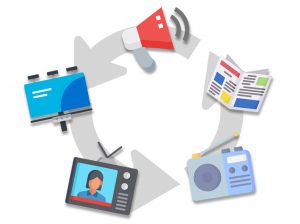
By Fletcher Pickett, VP Account Director, Hawthorne Advertising
Are the days of offline media numbered? Maybe not! Digital media like ads on websites, mobile apps, social media and connected or over-the-top (OTT) TV are often relatively pricey in comparison to other marketing options. Perhaps obviously, these channels of media are incredibly effective among younger demographics while producing data that can help marketers target and retarget consumers with high propensities to buy. This is a big answer to the question “Why? as brands are increasingly gravitating toward digital channels for ad campaigns.
That said, offline media is still highly effective, so marketers shouldn’t overlook its capabilities. “Offline media” generally includes everything else that’s not digital, such as ads on linear TV (i.e., scheduled network programming), terrestrial radio, billboards, print, etc. Offline media is mostly very efficient upon reaching large numbers of people, especially linear TV, which often outperforms other offline media categories.
Specific Use Cases for Offline and Online Media
Because it reaches many people efficiently, offline media like video ads on linear TV and audio channels such as non-digital radio are great options for businesses that are launching a new brand or expanding from a regional presence to a national footprint. Offline tactics are somewhat not as targeted as connected TV ad campaigns in comparison, but brands executing in these channels will yield more efficient impressions and often reach more people on a dollar comparison basis when they run on linear TV.
Another great use case for offline media: rolling out a new product from an established brand. If the company is already well known and has a popular family of products, offline media can be the best way to get the word out about a new product while leveraging the brand’s strength. Offline media also works incredibly well to introduce a new product type for the same reason it makes sense for brand launches: it reaches large numbers of consumers for less when compared to digital media.
That said, in some cases, a digital media-first strategy can make more sense. Indeed, if the marketer needs to reach a highly specific group of consumers — people who might be interested in buying a specific truck bed liner, for example — online media’s targeting capabilities are valuable. But for broad product categories, like adhesives, offline media is cost-efficient and highly effective.
Another use case where online media is a marketer’s best bet is when the product is targeted to younger consumers. To reach people in the 18 to 34 age group, digital media like connected TV is highly effective; people in that age range typically watch less linear TV and make up more than half of the connected TV audience. However, for reaching viewers in particular for aged 35 and up linear TV is a great option.
Offline media is also an excellent option for marketers who want to drive traffic to brick and mortar retail outlets. For example, a company that sells a product online through an ecommerce platform but also has a national distribution channel via retail partnerships and prefers to drive customers to those channels may have better luck using both strategically booked local and national offline media for that specific objective.
Think “Both And” Instead of “Either Or”
Online and offline media each have distinct advantages, and most marketers find success with a campaign that combines the two. For example, an established brand that is rolling out a new product might invest in offline media to announce the product launch and advertise on digital channels too, using the data generated to retarget likely buyers.
It’s more difficult today to reach the youngest consumers with offline media, but non-digital channels are enticingly efficient relative to other options for targeting older demographics. The bottom line? Keep in mind the value that offline media delivers, and tailor media buying strategies according to campaign objectives and consumer demographics. Think “both and” instead of “either or” because in many use cases, offline media still delivers more bang for the buck.
Fletcher Pickett has been at Hawthorne Advertising for 10 years, managing campaigns in excess of $250 million in total expenditures.





